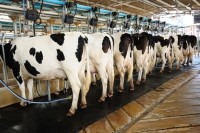Special Edition: Organic Feed
Australia: Industry led initiative looks to boost organic grain supply

With tremendous growth in the consumption of organic dairy products, in particular, in Australia, the market is demanding much more than what is available.
Certified organic crop cultivation – primarily wheat, oats and barley - in Australia now only represents 0.1% of total crop – some 70,000 hectares.

Katrina Hobbs, CEO of one of the biggest organic feed suppliers in Australia, Country Heritage, said the organic market is extremely sensitive to supply and demand fluctuations.
“While there has been some reasonable harvests amongst the various organic certified growers, [at] end of 2016, the general consensus was that the overall supply situation is still short.”
In terms of dealing with the organic grain supply challenge, she said Country Heritage works with new and existing growers in a wide geographical spread to plan crops, to ensure the supply needed.
“Sometimes supply [though] is so short we have had to turn down opportunities as a business,” said Hobbs.
There are a number of reasons for the deficit, including the fact that a group of four large organic growers sold their water rights in 2014 and exited the land, said Greg Paynter, owner of the Organic Advisory Service and former chair of the Organic Federation of Australia.
"Those represented 40% of the organic production in Australia when they were online," he said.
Barriers to entry
Pete Longhurst, director of the Brisbane headquartered organic and alternative grain trader, Primal Foods Group, said the Australian organic industry needs to work to remove barriers to entry, both in grain and in meat production.
Along with the three-year long process involved in the conversion to organic farming, he said potential new recruits to organic meat production in Australia are often scared off by the shortage of feed:
“Until we can give such farmers confidence about reasonably stable grain prices, we won’t be able to support the next level of market entrants,” he told us.
The organic pig production segment in Australia, for example, is practically non-existent and one reason is this feed availability and price volatility, said Longhurst.
However, the number of actual organic grain producers is now increasing, as well as the size of the average farm, he stressed.
Investment
Primal Foods Group has set up a team involving organic industry stakeholders, including some large-scale growers, to help the Australian organic food segments overcome the supply bottleneck. The team is looking to engage agribusiness focused investors.
The first objective is the boosting of volumes of certified organic grain produced in Australia: “Greater supply volume will bring much needed scale to the organic industry that will give processors confidence to invest in organic product lines that the market wants. Supply certainty and stabilized pricing will enable sustained near term growth.

“We are now working with mum & dad farms and we have been talking to investor groups in relation to converting farmland to certified organic production for grain and livestock.”
The team wants to increase the amount of available certified organic cropland in Australia to 200,000 hectares within three to five years.
Some investors want to buy and lease organic land, others are more interested in boosting the organic export business, he said.
Longhurst acknowledged the difficulties involved in capturing such capital as investors often want commitment from suppliers and buyers in advance. “This means we have to sign up the market and production at the same time, but we can only do what is feasible.”
The team, he said, is also aiming to optimize existing organic certified production by boosting return in dollars per hectare, by increasing the number of crops and diversity in crops, and by employing techniques that reduce costs, increase soil moisture retention and overall productive capacity.
Research
Developing research and sharing knowledge around organic farming is another priority.
Longhurst spoke to the lack of Australian government funding, to date, for organic production studies.
“First stop then is identifying funding for Australian research. In the meantime, we continue to lean heavily on what is happening in US and Europe. There is an industry working party addressing this currently.
“Where we, in Australia, are at right now, is where the US sector was in the early 80s. Therefore, we have a lot to learn from the associations there about how they successfully managed growth. The US industry also has 30 years of federally backed research data to fall back on, something we can leverage as well.”
Dairy dynamic
Growth in the poultry production side of organic farming in Australia is currently quite limited. The segment was severely challenged in the 2014 to 2015 grain shortfall, but Longhurst noted that most producers are still in business. “They managed to ride it out despite the market responding negatively to their passing on of higher production costs to consumers.”
Dairy produce is the clear winner in the organics stakes Down Under: by 2014, it was the fastest-growing and most valuable organic category, commanding 22.3% of total organic farm-gate sales, with total farm-gate value nearing $114m, up from $29m in 2011 – and retail sales of $325m, according to Australian Organic Market Report 2014.
Indeed, certification body, Australian Certified Organic (ACO), is currently seeing a rapid increase in the number of dairy operations applying for certification, said Longhurst.
However, the organic grain supply will have to increase dramatically if the projections of milk output by the organic dairy sector for 2020 are anything to go by, he added.

He noted the shift away from home mixing to compound feed and pellet use in Australian organic dairy rations, though, is helping to increase efficiency in production.
Dairy processors are actively encouraging producers to switch to organic farming.
Northern Victorian based company, Australian Consolidated Milk (ACM), told ABC News in November last year that it was offering a guaranteed premium price of $8 per kg of milk solids for two years to farmers who convert to organic dairy production.
It said then that it had 30 suppliers in the midst of converting to organic dairy production.
ACM general manager, Peter Jones, said the processors and many of its suppliers had been keen to enter the organic milk space for a long time, with the company's plant in northern Victoria accredited for organic milk processing.
Demand was the main driver behind ACM's decision to get into the organic market: "The Australian organic industry is about a $2bn dollar industry and growing at about 15% per annum, with dairy the fastest growth category in that segment."













